|
Pisa, December 10, 2003
INTERVIEW WITH TONINO VALERII
We wish to thank the director Tonino Valerii for the time he gave us and his kindness, without which this interview would not have been possible.
Federica: Good-evening. I'm so happy
to meet you because my favourite film of all time is My Name
is Nobody. I'm a fan of Terence Hill's, not a journalist,
but I manage his official website Let's talk about the film. Where
was it filmed?
Tonino: We scouted out many locations. I travelled around
a lot, up and down America, to find the right locations...
Federica: I heard the film was made in Santa Fè (New Mexico,
USA, editor).
Tonino: No. We went to Santa Fè and checked it out, but
it's a modern town, and the old, if it's there at all, is mixed
in with the new.
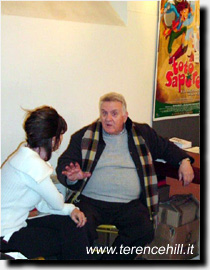 Federica: I've heard that a lot of care went into the making
of the film.
Federica: I've heard that a lot of care went into the making
of the film.
Tonino: Yes. A lot of care went into the making of the
film, and a lot of money.
Federica: Could you tell me something about Terence Hill?
Tonino: He's a wonderful actor, and anything good thing
you can say about someone, you can say about him, because he's
really a wonderful man. Terence was a star, he still is a star,
but back then he was already a star, suddenly he had become a
star on the same level as Clint Eastwood. If we take a look at
the numbers, Terence's films earned more than Clint's. My Name
is Nobody is the Italian western that has earned more than
any other.
I remember that when he arrived on the set in the morning, he
seemed to float four meters above ground, and we were all tense,
but he was calm. Later I learned that every morning, before arriving
on the set, he did two hours of yoga!
Federica: I have a few specifics to ask you. The film has
a serious storyline, consistently, but, I think, there are some
scenes that stand apart from the rest of the film. One is when
he appears to dry his hand, and then he pulls his thumb out of
his fist and a match lights. It seemed strange to me, odd anyway...
Tonino: Why?
Federica: Because I didn't understand what it meant...
Tonino: Let's see if I can explain it. He was trying to
catch a fish, so he put an insect on the water and stood ready
with a stick. The boat arrives, Henry Fonda gets off with his
horse and then stops to watch him, with an expression of disdain,
with a small smile as if to say "look at this guy and what
he's doing". After he gets the fish, Jack comes before him,
and Nobody sees him and goes (mimes the gesture described above,
editor), but this gesture means something precise, "will
you give me a lift? I don't have a horse! I have a saddle, but
I don't have a horse, so give me a lift". Actually, first
he sees him moving his thumb to dry it, then he looks at the saddle
and when he looks back the thumb takes on the hitch-hiking gesture.
Even if the audience didn't quite get it, we had hoped they would,
so I'm sorry that we didn't succeed. Then he goes (mimes the gesture,
editor) and it lights up!
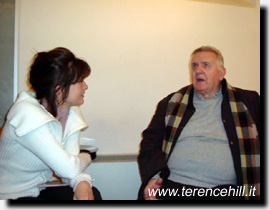 Federica: Did he have a lighter in his hand?
Federica: Did he have a lighter in his hand?
Tonino: No, it was an American match. At the tip there
is sulphur, so a fingernail is enough to light it.
Federica: I see. It seemed to me that the match lit itself,
even if you see that he's holding something, without seeing the
match, as a child I thought it was a magic trick, like Stan from
Stanley and Oliver. The other scene is when he has his saddle
on his shoulder, he takes out his pistol and with the same hand
he manages to hold onto the saddle. This isn't possible...
Tonino: Not possible, why not? It's funny, don't you think?
I mean, behind him the saddle creates the illusion of a pair of
wings...
Federica: That's true! I noticed that.
Tonino: ...he's an angel, of sorts, that's what we wanted
to say, and then we wanted to play with the character of a show-off,
so what does he do? He gets rid of the saddle, takes the pistol,
he puts it in the holster and gets the saddle again. This can't
normally be done, so we filmed it in slow motion. What I mean
is, we had Terence do all the movements slowly, then we put in
the trick and speeded it up.
Federica: You can see that! I was curious why these scenes
were put in the film that is for the most part very realistic.
Tonino: "Very realistic", we should be clear
on the expression. Terence Hill is a Peter Pan character, a character
than doesn't want to grow up, that is associated with Peter Pan.
Which means he's retained his childhood values, from fairy tales.
He even says "when I was a boy I used to play Jack Beauregard"
It's a fantasy, or a dream. He dreamed all his life of meeting
a real hero of the west. Unfortunately by the time he gets there,
the west is gone, consigned to history and the last character
is leaving, because he's understood that the game is up.
One day, with Terence Hill, we drove to Paris to present the film
to the French producers. We were walking along the Champs Élysées
and I explained to him the story of Peter Pan because up to then,
we hadn't talked about it. What Leone said was "I want that
one of Clucher's characters clashes with one of my characters".
But he didn't want to clash with Clucher personally, who was a
dear friend of his, so he called me to make this film.
With Terence, I didn't have a chance to talk about this before,
so when we were in Paris for a few days, he asked me, "Listen,
why don't you tell me a bit about my character?", I had this
idea to explain to Terence what I wanted to make. "It's simple,"
I said "Nobody, is a young man who doesn't want to grow up,
and not wanting to grow up, he continues to feed his childhood
fantasies, only they actually come true for him. The difference
is that for him, the fantasies he dreamt as a child, actually
come true, and that's all".
Federica: That's very interesting! Another little curiosity
that some asked me about is the doll that at one point Nobody
plays with.
Tonino: That's the Saracen Joust. It's a thing that exists in Italy, one of the contaminations the Italian western created.
Federica: I'll tell you why I asked that, it's because some people have seen Bud Spencer in that doll.
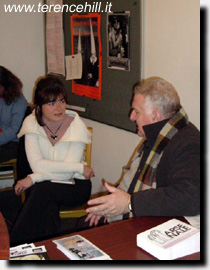 Tonino: No, absolutely not. In the Challenge of Barletta by Blasetti (see the film "Ettore Fieramosca" by director Alessandrio Blasetti, editor), at a certain point there is a doll to stab, and whomever manages to do that, wins, and if you don't pierce the doll, if you don't get it right, it turns and hits you in the head and you fall down. It's the famous Saracen Joust that is played not only in Puglia, but also in other parts of Italy.
Tonino: No, absolutely not. In the Challenge of Barletta by Blasetti (see the film "Ettore Fieramosca" by director Alessandrio Blasetti, editor), at a certain point there is a doll to stab, and whomever manages to do that, wins, and if you don't pierce the doll, if you don't get it right, it turns and hits you in the head and you fall down. It's the famous Saracen Joust that is played not only in Puglia, but also in other parts of Italy.
And then there's the little song, "what a beautiful castle...", that is Italian, a children's poem that's told or sung to small children. As you can see, we keep coming back to the childhood fantasies that return in the games of adults.
The most beautiful part of that bit is when Terence Hill hides and calls to Benito Stefanelli, who was the stunt-director, and he goes (mimes the gesture, editor) come here, come here, first he gives him a couple of punches and then he rolls him into a ball and makes him fly over the billiard table which is on the other side. These are games that we loved played, like the story of the little bird. That was a famous joke that we told when I was in school.
Federica: Did you use it all exactly like the original, or was it adapted?
Tonino: No, we used the original as we heard it when we were boys. These are things that Castaldi and I used; he was the scriptwriter. We knew all these stories. We gave them to a new generation, instead of letting them die out with us.
Federica: I was very impressed by the spectacle of the scene in which Jack Beauregard fires on the gang and they explode because they were carrying dynamite. How was that filmed and were the horses supposed to fall down like that?
Tonino: Of course, and there's no trick to it. Clearly there is a way of making a horse go down without hurting the animal, and in my films no horses were ever hurt.
Federica: My compliments on the wonderful results.
Tonino: These scenes came out well, and they still come out well.
Federica: Tell me a bit about the various film locations.
At this point, Tonino Valerii talks ...and I let him...
THE SKY CITY
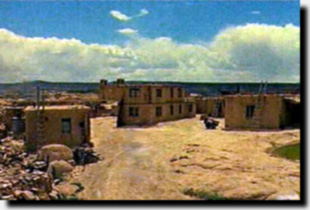 Among the various places we visited when looking for locations
for filming, was a place called Acoma.
Among the various places we visited when looking for locations
for filming, was a place called Acoma.
This is a town called "The sky city" because it is at
an altitude of 11,900 feet, which is about 5000 meters. You get
there by passing through the town in America that is richest with
uranium, so when you go through, you become radioactive. Pregnant
women can't stay there and the men who work there, can only stay
for a specific amount of time and then they have to leave.
To get there, there is a narrow road that on one side is mountain
and on the other side a precipice. Since we were driving American
cars, me too, nothing like a Fiat 500, I drove a big car of a
make I can't remember, but it was an enormous car and, truthfully,
to get there each time took two hours, and it was very dangerous.
Once we got to Acoma, the first thing I saw was the Catholic church.
I went inside and there was this wooden crucifix of such beauty
that I was struck dumb. So I called the tribal Chief (Cacique)
and I asked him, " Are you 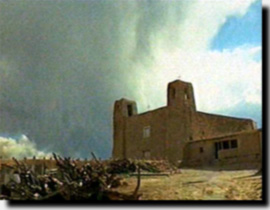 Catholic?"
- "Yes, we're Catholic" - "And how is it that you're
Catholic?" I asked. And he told the story. He was a very
educated man, over sixty years old. He explained that Acoma was
on the famous Jesuit-trail, which was the trail of the Jesuits
who travelled across America. Wherever they went they built churches
and converted people. I was completly taken by the story, because
this town had remained exactly how it was in the time of the Indians;
from the 1600's on, it hadn't changed. There are no doors. You
see only blocks without doors, and they enter from the roof and
then close the hole to make it a block, and there is only an opening
for the smoke. At a certain point, I saw a cemetery and I thought,
"How fantastic; this is the cemetery that I was looking for".
And the Chief was with me, so I said to him, "We want to
film here". "No, you can't film here; it's taboo because
these are our ancestors buried here. If you want to go in and
look around, okay, but you can't film here" - "Maybe?"
I said "No. Do you like this cemetery? Then we'll rebuild
it for you" - " No. Do you like this cemetery? Then
we'll rebuild it for you" - "Here, next to it".
I looked and I saw a drop of 150-200 meters. "But how can
you build it?" He says, "Mister director, that's our
business!" He actually said that! " Don't you worry.
All you have to say is how you want it and what you want changed"
- "No, I want it just like this" - "When do you
need it?" - "In two months." - "In two months,
it will be ready.". I didn't trust him, so I called our production
manager Cappellone (we gave him that nickname because when
he arrived in America he bought a big cowboy hat), and I said
to him, "Look, I don't trust these people. And how are they
going to remake the cemetery here?". Catholic?"
- "Yes, we're Catholic" - "And how is it that you're
Catholic?" I asked. And he told the story. He was a very
educated man, over sixty years old. He explained that Acoma was
on the famous Jesuit-trail, which was the trail of the Jesuits
who travelled across America. Wherever they went they built churches
and converted people. I was completly taken by the story, because
this town had remained exactly how it was in the time of the Indians;
from the 1600's on, it hadn't changed. There are no doors. You
see only blocks without doors, and they enter from the roof and
then close the hole to make it a block, and there is only an opening
for the smoke. At a certain point, I saw a cemetery and I thought,
"How fantastic; this is the cemetery that I was looking for".
And the Chief was with me, so I said to him, "We want to
film here". "No, you can't film here; it's taboo because
these are our ancestors buried here. If you want to go in and
look around, okay, but you can't film here" - "Maybe?"
I said "No. Do you like this cemetery? Then we'll rebuild
it for you" - " No. Do you like this cemetery? Then
we'll rebuild it for you" - "Here, next to it".
I looked and I saw a drop of 150-200 meters. "But how can
you build it?" He says, "Mister director, that's our
business!" He actually said that! " Don't you worry.
All you have to say is how you want it and what you want changed"
- "No, I want it just like this" - "When do you
need it?" - "In two months." - "In two months,
it will be ready.". I didn't trust him, so I called our production
manager Cappellone (we gave him that nickname because when
he arrived in America he bought a big cowboy hat), and I said
to him, "Look, I don't trust these people. And how are they
going to remake the cemetery here?".
RIO PUERCO
We continued to travel around. At a certain point, I was contacted by the director of a municipal department (like we have here for tourism or special events, etc.), who had helped us from the beginning. She was a very kind and helpful woman who advised me to go and look at the region of Rio Puerco.
We looked at the map and realized that to get there we had to drive 5 - 6 hours. So one morning I decided to get up at 4 and go have a look. We left with two cars that the woman gave us to use,
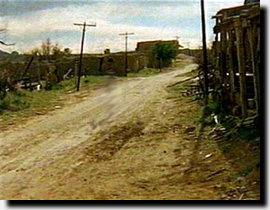 and after three and an half hours along a beautiful highway, we found ourselves in the middle of the countryside, without any idea which way to go. We continued like this for an hour and an half, and we were about to turn back because we still couldn't see a thing, when finally we saw something far off. There was a narrow bridge without side rails. It was low, that if you fell off, you would at most break a leg, so we decided to risk the crossing.
While I'm crossing I see a sign that sa "maximum one ton", so I get out and go to Cappellone, who was behind us, and I tell him that we can't film here. It was already dangerous to pass with our cars, because an American car is at least a ton, that's about 10 quintals in weight, actually, much more than that, but an electrician's unit that weighs 10 tons and has a wide truck bed would not be able to cross the bridge safely. This guy looks at me with a fed up expression and he says, "Listen, Tonino, do me a favour, you do the directing and let me do the organizing." - "I'll take you at your word." - "Take me at my word". We get there and find a complete western village protected by a fence and a sign that says "Private Property. Warning. Anyone crossing the barbed wire must pay a 500 dollar fine.", But there was nobody there. We called out, but no one answered. So we went past the fence, and we didn't get more than one meter when a crazy guy on a horse arrives with a pump-action Winchester rifle, which he points at us, actually he pointed it right at me... "Halt? Didn't you read the sign?"-"Yes, I read it. I'm sorry. You're right. But we were looking for someone to talk to about making a film here..." - "You can't" - "If we can't, we won't. Can we visit the village?" - "Yes, if it just to look, that's okay".
and after three and an half hours along a beautiful highway, we found ourselves in the middle of the countryside, without any idea which way to go. We continued like this for an hour and an half, and we were about to turn back because we still couldn't see a thing, when finally we saw something far off. There was a narrow bridge without side rails. It was low, that if you fell off, you would at most break a leg, so we decided to risk the crossing.
While I'm crossing I see a sign that sa "maximum one ton", so I get out and go to Cappellone, who was behind us, and I tell him that we can't film here. It was already dangerous to pass with our cars, because an American car is at least a ton, that's about 10 quintals in weight, actually, much more than that, but an electrician's unit that weighs 10 tons and has a wide truck bed would not be able to cross the bridge safely. This guy looks at me with a fed up expression and he says, "Listen, Tonino, do me a favour, you do the directing and let me do the organizing." - "I'll take you at your word." - "Take me at my word". We get there and find a complete western village protected by a fence and a sign that says "Private Property. Warning. Anyone crossing the barbed wire must pay a 500 dollar fine.", But there was nobody there. We called out, but no one answered. So we went past the fence, and we didn't get more than one meter when a crazy guy on a horse arrives with a pump-action Winchester rifle, which he points at us, actually he pointed it right at me... "Halt? Didn't you read the sign?"-"Yes, I read it. I'm sorry. You're right. But we were looking for someone to talk to about making a film here..." - "You can't" - "If we can't, we won't. Can we visit the village?" - "Yes, if it just to look, that's okay".
It was beautiful, but missing only one thing. Do you remember the beginning when Henry Fonda comes out of the hotel and reads the telegram "Sundown will leave on this day"? The hotel wasn't there, and we had to build it but we didn't even know how. Anyway, we decided it was great. We gave a tip to the crazy guy with the gun, and asked him who we had to ask about getting permission to film there. He gave us the name of a lawyer.
We went back to town, another 5 hours travelling. The next morning, after making the request of the law firm to film in the village, and to do some additional construction, they answered that we had to get permission from all the owners of the buildings because every single building was owned by someone different. Four lawyers worked on it and it cost us 10,500 dollars, one in New York, one, I don't know...in all four directions! They were very professional, getting all the permission forms, building by building, one for 300 dollars, another for 200, another for 500, each negotiated separately.
THE HOTEL
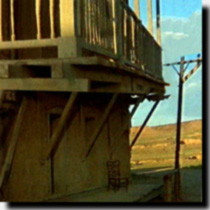 We had to build the hotel, so we continued to travel around and we got to a lovely town called Socorro, a famous western town. I saw a beautiful hotel that was still in it's original state. This town is a museum and the hotel was roped off, so you couldn't see inside because it was too dangerous. Gianni Polidori was with me, the set designer, and I said to him, "Gianni, that hotel that we talked about, I want it like this one". He said, "Okay. Let's take photos..." "No, wait. I'll show you what we'll do". I went to the tobacconist and I said, "Do you have post cards? Is there one of the hotel?" "Yes, here it is!" And then I went back to Gianni, "Gianni, here's the photo. You have to make this!"
We had to build the hotel, so we continued to travel around and we got to a lovely town called Socorro, a famous western town. I saw a beautiful hotel that was still in it's original state. This town is a museum and the hotel was roped off, so you couldn't see inside because it was too dangerous. Gianni Polidori was with me, the set designer, and I said to him, "Gianni, that hotel that we talked about, I want it like this one". He said, "Okay. Let's take photos..." "No, wait. I'll show you what we'll do". I went to the tobacconist and I said, "Do you have post cards? Is there one of the hotel?" "Yes, here it is!" And then I went back to Gianni, "Gianni, here's the photo. You have to make this!"
To build it, we hired an army of workers who looked like they came from, I don't know where, with long hair and moustaches, drug-addicts, drunkards. Looking at them, I though that they would never be able to finish building it. But instead, once they got started, it was an amazing thing. I've never seen a group of workers on a film set work with such dedication. All you had to do was ask for something, and they did it to perfection. They made the hotel, as we all saw, and it was perfect!
ACTION, WELL, NOT QUITE...
Finally, the first day of shooting the film arrived. Sergio Leone sent me a beautiful telegram, "I'm sure you'll make a beautiful film" And we were off. In the morning, after 5 hours in the car, we got there. Henry Fonda was already made up, and we had made a barber shop with a net: that was thanks to our wonderful set designer. It was really just a ruin, and he didn't do anything very complicated, but took an old fishing net that he found, extended it and it was the most beautiful thing I've ever seen done by a set designer. Otherwise there was nothing, and we added a chair and the other things.
As I said, it was the first day, so I checked everything, and I started having them light the set, and I explain to the camera operator where to put the camera and what he needed to do. When it was ready, the camera operator said, "We're ready". "Call Mr. Fonda". Mr. Fonda arrived and I said, "Lights", and everyone looked around... "Who's he talking to?" "The electricians group never got here". "Don't say stupid things. The group never arrived? The group arrives everywhere. We all knew we were starting today. The group should have been here already". As I was talking, I was looking at Cappellone and he was looking around. We had started out at 4 in the morning and arrived around 10. I said, "What are we going to do? Do we want to film a few takes at least, so we can say we started?" I look at Cappellone and Cappellone says, "They're not coming". "What do you mean, They're not coming? You told me to mind my own business, well, I am minding my business, and you should mind yours or you're an idiot. Do you know who's here?" We were 47 people from Rome, the crew, with the actor, with the American. The Chief electrician was an American. "We can't look this ridiculous. The Italians arrive and they can't film on the first day because the electricians group couldn't get through. Go get the car and see where the group is", I ordered. He came back a few hours later, and it was already noon. He was as pale as a cadaver, and he said, "They can't get over the bridge". "This isn't possible," I said. "What do you mean they can't get over the bridge. You told me to mind my own business, which I did, and now they can't get over the bridge. So you really are incompetent. The moment I get back to the hotel, I'm calling Sergio Leone and I'm going to tell him to send me another guy". "No. No, please. Don't do that to me". "Let's go!"
What could we do? By now the hotel was built, and it cost a lot of money, so the location was that one, and we couldn't start over someplace else. Do you know how it ended? The American military built a bridge. We had to wait 10 days, and do you know how much this cost Mr. Leone, who was the producer? With the value back then, it cost 185,000. dollars. One dollar, I'll never forget, was 690 to the lira, at the time.
THE CEMETERY
Meanwhile, the construction of the cemetery was going ahead. I sent someone every now and then to check on it, and they told me they were putting in enormous diagonal supports, topped by big beams. Of course they constructed it over the ravine, to create a platform, with the construction workers hanging there from cables!
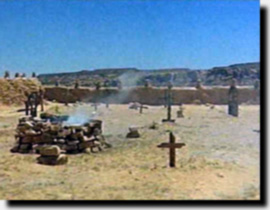 The day arrived when we had to film in Acoma. We arrived and the real cemetery went to here, and next to it began the fake one, above the precipice. I went around to see how it was supported and there were these big heavy wooden beams, on a diagonal, that is, all on a transverse line. I'm not sure how to explain it, but there was the cemetery. So I said to the tribal Chief, "We have to get a camera and an entire film crew on this". "Don't you trust it?" "I don't know. Has it been tested?" I asked him. "We don't need any test; we can assure you that it will hold". "I'm sorry, but if it's not tested by an engineer, who says it I can hold at least 40 people..." "How many people have to get on it?" "40". He started talking in his Indian language and soon over 100 people arrived. That's practically everyone from their Indian village. They all got on the cemetery and then he had them all jump up and down together. To tell you the truth, it didn't move at all. "Amazing. This, for me, is a good test", I thought, and we filmed there for a day and an half or a few days.
The day arrived when we had to film in Acoma. We arrived and the real cemetery went to here, and next to it began the fake one, above the precipice. I went around to see how it was supported and there were these big heavy wooden beams, on a diagonal, that is, all on a transverse line. I'm not sure how to explain it, but there was the cemetery. So I said to the tribal Chief, "We have to get a camera and an entire film crew on this". "Don't you trust it?" "I don't know. Has it been tested?" I asked him. "We don't need any test; we can assure you that it will hold". "I'm sorry, but if it's not tested by an engineer, who says it I can hold at least 40 people..." "How many people have to get on it?" "40". He started talking in his Indian language and soon over 100 people arrived. That's practically everyone from their Indian village. They all got on the cemetery and then he had them all jump up and down together. To tell you the truth, it didn't move at all. "Amazing. This, for me, is a good test", I thought, and we filmed there for a day and an half or a few days.
The Indians that you see in the film, are the actual inhabitants of that village, and the costumes that they wear are costumes they took from their chests, which were the costumes of their grandparents and parents, original costumes from the time in which the film was set.
Federica: For my last question, I've saved what interests me the most. I've always thought that My Name is Nobody had all the ingredients of a story that would have a sequel...
Tonino: You're right. In fact, I have a script in a drawer, but as you know, there's a big difference between saying something and actually doing it!
With the interview over, we went into the cinema where we watched the films "A Reason to Live and to Die", with Bud Spencer, and "My Name is Nobody"..
After which, the meeting began. Below I've transcribed some of the more interesting bits:
IN THE CINEMA
A meeting arranged and paid for by the University of Pisa's course in Cinema, Music and Theatre.
Held at the Cineclub Arsenale di Pisa.
The Interviewer is Professor Piermarco De Santi, professor with the University of Pisa's History of Italian Cinema program.
PRESENTATION
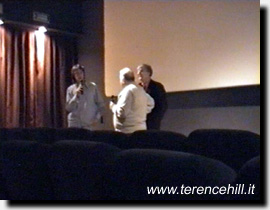 "Tonino Valerii is a graduate of direction from the Centre for Cinema Experimentation (Centro Sperimentale di Cinematografia). After graduation, he worked as an assistant director for many directors: Camillo Mastrocinque (director of many of Totò's films), Alessandro Blasetti and with Sergio Leone, who he helped make "For a Fistful of Dollars". Then he debuted in '66 with "Taste for Killing" (Per il gusto di uccidere), which means his debut was in the western genre. In '67 he directed one of his most famous films, "Days of Wrath" (I giorni dell'ira). In '69 he directed "The Price of Power" (Il prezzo del potere), and later many police films like "My Dear Killer" (Mio caro assassino) and "Go Gorilla Go" (Vai Gorilla), from the mid-seventies. Let's not forget the two films we just watched which are "A Reason to Live, a Reason to Die" (Una ragione per vivere e una per morire) and "My Name is Nobody" (Il mio nome è Nessuno). He's also been a screenwriter, helping write many films, besides his own, but in fact he was writer on many of his own films and scripted the dialogues. Later he worked quite a bit in television with the RAI and he's written a book, "Being an Assistant-Director in Film and TV" (Fare l'aiutoregista nel cinema e nella tv), which serves as a guide for young, aspiring directors, on which many new directors have relied".
"Tonino Valerii is a graduate of direction from the Centre for Cinema Experimentation (Centro Sperimentale di Cinematografia). After graduation, he worked as an assistant director for many directors: Camillo Mastrocinque (director of many of Totò's films), Alessandro Blasetti and with Sergio Leone, who he helped make "For a Fistful of Dollars". Then he debuted in '66 with "Taste for Killing" (Per il gusto di uccidere), which means his debut was in the western genre. In '67 he directed one of his most famous films, "Days of Wrath" (I giorni dell'ira). In '69 he directed "The Price of Power" (Il prezzo del potere), and later many police films like "My Dear Killer" (Mio caro assassino) and "Go Gorilla Go" (Vai Gorilla), from the mid-seventies. Let's not forget the two films we just watched which are "A Reason to Live, a Reason to Die" (Una ragione per vivere e una per morire) and "My Name is Nobody" (Il mio nome è Nessuno). He's also been a screenwriter, helping write many films, besides his own, but in fact he was writer on many of his own films and scripted the dialogues. Later he worked quite a bit in television with the RAI and he's written a book, "Being an Assistant-Director in Film and TV" (Fare l'aiutoregista nel cinema e nella tv), which serves as a guide for young, aspiring directors, on which many new directors have relied".
PROFESSOR DE SANTI'S INTRODUCTION
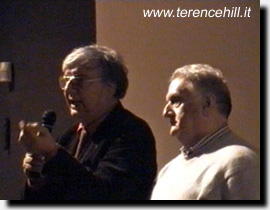 I'm very happy that the students in the Cinema, Music and Theatre program are involved in these initiatives that permit them to know that part of Italian and international cinema that in other ways they would never be able to get close to but especially to compare and to know the artists who are offering us their great cooperation and who help us therefore to aide in the recognition and the recalling Italian cinema which would otherwise, well, who knows, with all the talk in books about the history of cinema, today no one seems to know anything. These films that we are showing are from around the seventies, and therefore if you think about our students, especially those in their first year, were born in 1980-81, clearly they've never seen these films. Therefore I'm very grateful to Tonino Valerii who is here with us today, and the students may not know, but Tonino Valerii, besides being a major genre auteur, of mainly the Italian and non-Italian western, and police cinema, is a very cultured man, cultured in the figurative sense, but mainly in the sense of the culture of cinema. He has a profound and unique ability to frame and to direct a scene, which was developed while making genre films, in this case, the Italian western, leading him to, let's say, find innovative solutions to directing, narrating and dramatic problems. In his day, when this film was released, My Name is Nobody, it enjoyed, as you know, great public success. Some critics noted, honestly, how should I say this, this surgical work from the inside of the genre, as if to get at the destruction of the classic myth of the western. Others, instead, didn't understand a thing, and from their haughty and arrogant position preferred to say nothing, or to actually ignore this type of cinema that today is instead rightly valued and studied with great attention. Just look beyond the great character of the director and auteur Tonino Valerii, and run down the credits of this film, and you'll see that working on this project were the top of the so-called great Italian cinema. The editor was Nino Baragli. Music by Ennio Morricone. Writers and scriptwriters of top class. The Director of Photography, well, let's just say that this film,,
I'm very happy that the students in the Cinema, Music and Theatre program are involved in these initiatives that permit them to know that part of Italian and international cinema that in other ways they would never be able to get close to but especially to compare and to know the artists who are offering us their great cooperation and who help us therefore to aide in the recognition and the recalling Italian cinema which would otherwise, well, who knows, with all the talk in books about the history of cinema, today no one seems to know anything. These films that we are showing are from around the seventies, and therefore if you think about our students, especially those in their first year, were born in 1980-81, clearly they've never seen these films. Therefore I'm very grateful to Tonino Valerii who is here with us today, and the students may not know, but Tonino Valerii, besides being a major genre auteur, of mainly the Italian and non-Italian western, and police cinema, is a very cultured man, cultured in the figurative sense, but mainly in the sense of the culture of cinema. He has a profound and unique ability to frame and to direct a scene, which was developed while making genre films, in this case, the Italian western, leading him to, let's say, find innovative solutions to directing, narrating and dramatic problems. In his day, when this film was released, My Name is Nobody, it enjoyed, as you know, great public success. Some critics noted, honestly, how should I say this, this surgical work from the inside of the genre, as if to get at the destruction of the classic myth of the western. Others, instead, didn't understand a thing, and from their haughty and arrogant position preferred to say nothing, or to actually ignore this type of cinema that today is instead rightly valued and studied with great attention. Just look beyond the great character of the director and auteur Tonino Valerii, and run down the credits of this film, and you'll see that working on this project were the top of the so-called great Italian cinema. The editor was Nino Baragli. Music by Ennio Morricone. Writers and scriptwriters of top class. The Director of Photography, well, let's just say that this film,,
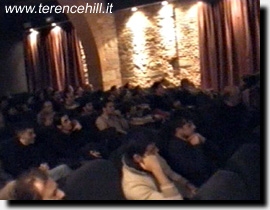 directed by Tonino Valerii, took advantage of the great talent that at that time was working with Fellini, with Sergio Leone, with Visconti, etc... Therefore they bring to this genre a noteworthy contribution of a high artistic level, and we are in the workshop of a great artisan of the cinema. The culture, obviously, of the film emerges also from the many directorial solutions, let's say, in the setting up of a scene, and within this film we have an homage to cinema. There is the homage to Chaplin, and there are a series of moments that refer to the western film which act as a 'demythification' of the genre. There is the reference, for example, to the famous gag of Chaplin's when he eats the child's food, and here Terence Hill eats the apple, but the situation is comparable. There is even an intelligent bit which works as a refinement of the soundtrack of the western film, also experimented with by Sergio Leone, of course, and by Ennio Morricone. The soundtrack of this film is known throughout the world, but besides this, there are many self-references, when Morricone uses an occasional self-reference, which recall, especially in the moment of the duel, the sounds of the trills in the film The Good, The Bad and the Ugly, and so on. Then, for example, that wonderful piece from the charge with the insertion of the electronic keys, a bit ironical, a bit grotesque, from the Charge of the Vacherie, the famous Wagnerian passage, which plays a role in the asymmetry. Generally the Charge of the Vacherie recalls the Wagnerian myth, recalling something from another era and in this case it is applied to a group of misfits which is decontextualized, and a perfect example of asymmetry. All this is just to tell you, to underline the fact that, these attitudes of self-importance and haughtiness by the critics should be left behind. I want to say that, for example, if you were to present Tonino Valerii tonight, based on the classic criticisms, then you would find nothing, because there was this attitude that defended the so-called cinema of the auteur, as if this type of cinema didn't have an Auteur behind it. They always made the distinction between the auteur with a capital "a", and the auteur of, let's say, the films that were block-busters or for mass-market consumption. So, students, you should take all of that with a grain of salt, as it's a bunch of rubbish, linked to the academies, to the rhetoric of the universities, to all these pompous fools who are no longer around. We must look at the data, to look at the films, and not take anything for granted, watching the films, studying them, watching with a critical eye and then expressing our own opinion. We must not do as pseudo-intellectuals do, who having not even seen a film, write a few lines disposing of the issue. Do you think that Henry Fonda was an actor so unaware or, let's say, out of his head to, once having read the script or met Tonino Valerii, to have accepted to make a film of this type just because, who knows, he needed the money? Henry Fonda understood very well, having been one of the great stars of the classic western, that this film was a film that broke the mould, that it was a film that had originality, that took the genre in a different direction, that moved the goalposts and surprised people out of the ordinary. If Henry Fonda was not deceived, I don't see why we have to be either.
directed by Tonino Valerii, took advantage of the great talent that at that time was working with Fellini, with Sergio Leone, with Visconti, etc... Therefore they bring to this genre a noteworthy contribution of a high artistic level, and we are in the workshop of a great artisan of the cinema. The culture, obviously, of the film emerges also from the many directorial solutions, let's say, in the setting up of a scene, and within this film we have an homage to cinema. There is the homage to Chaplin, and there are a series of moments that refer to the western film which act as a 'demythification' of the genre. There is the reference, for example, to the famous gag of Chaplin's when he eats the child's food, and here Terence Hill eats the apple, but the situation is comparable. There is even an intelligent bit which works as a refinement of the soundtrack of the western film, also experimented with by Sergio Leone, of course, and by Ennio Morricone. The soundtrack of this film is known throughout the world, but besides this, there are many self-references, when Morricone uses an occasional self-reference, which recall, especially in the moment of the duel, the sounds of the trills in the film The Good, The Bad and the Ugly, and so on. Then, for example, that wonderful piece from the charge with the insertion of the electronic keys, a bit ironical, a bit grotesque, from the Charge of the Vacherie, the famous Wagnerian passage, which plays a role in the asymmetry. Generally the Charge of the Vacherie recalls the Wagnerian myth, recalling something from another era and in this case it is applied to a group of misfits which is decontextualized, and a perfect example of asymmetry. All this is just to tell you, to underline the fact that, these attitudes of self-importance and haughtiness by the critics should be left behind. I want to say that, for example, if you were to present Tonino Valerii tonight, based on the classic criticisms, then you would find nothing, because there was this attitude that defended the so-called cinema of the auteur, as if this type of cinema didn't have an Auteur behind it. They always made the distinction between the auteur with a capital "a", and the auteur of, let's say, the films that were block-busters or for mass-market consumption. So, students, you should take all of that with a grain of salt, as it's a bunch of rubbish, linked to the academies, to the rhetoric of the universities, to all these pompous fools who are no longer around. We must look at the data, to look at the films, and not take anything for granted, watching the films, studying them, watching with a critical eye and then expressing our own opinion. We must not do as pseudo-intellectuals do, who having not even seen a film, write a few lines disposing of the issue. Do you think that Henry Fonda was an actor so unaware or, let's say, out of his head to, once having read the script or met Tonino Valerii, to have accepted to make a film of this type just because, who knows, he needed the money? Henry Fonda understood very well, having been one of the great stars of the classic western, that this film was a film that broke the mould, that it was a film that had originality, that took the genre in a different direction, that moved the goalposts and surprised people out of the ordinary. If Henry Fonda was not deceived, I don't see why we have to be either.
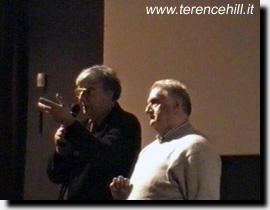 Professor: One extraordinary solution is linked to the moment of the shoot-out, which usually in the western genre last 5 to 6 minutes. There is this gunfire and the fall of the horses, rifle fire, a shoot-out, etc. that is shown with a special effect as a fixed image, in a photo album, as if to put the character, to quote from the film, "fixed in history". It is fixed in the illustration in the western era. This is for me a brilliant solution, using the setup of the scene. Was it in the film from the beginning, already in the script?
Professor: One extraordinary solution is linked to the moment of the shoot-out, which usually in the western genre last 5 to 6 minutes. There is this gunfire and the fall of the horses, rifle fire, a shoot-out, etc. that is shown with a special effect as a fixed image, in a photo album, as if to put the character, to quote from the film, "fixed in history". It is fixed in the illustration in the western era. This is for me a brilliant solution, using the setup of the scene. Was it in the film from the beginning, already in the script?
Tonino: Yes, it was all in the script. The only thing not in the script was the scene in the "public urinal", which was added by Sergio Leone.
Professor: The music of Morricone plays a fundamental role?
Tonino: Of course, just as in all of Leone's films. Morricone's music is like a beautiful suit dressed around a slight person. For example, when we saw the first showing of For a Few Dollars More, we realized that with the music, it had changed completely.
Professor: This could be just a coincidence, but in the cemetery, when the dead are named, there is also a certain Sam Peckinpah, who is a director. Was this just by chance? Or is it a joke like, "okay, let's kill off Sam Peckinpah?"
Tonino: No. Absolutely, no. It happened like this, writing the scene, Castaldi and I couldn't think of an American name that we liked so he said, "it should be something like Sam Peckinpah, that sounds good", and we wrote it down like that, thinking we would come up with something else later. When Sergio Leone read that scene, he said, "No, leave it like that because you'll see that some journalist will notice and write about it". It was done in a provocative way.
Professor: He is a great director of American cinema.
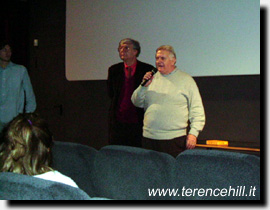 Tonino: He's the director of "The Wild Bunch".
Tonino: He's the director of "The Wild Bunch".
Professor: It's only right that we mention "The Wild Bunch".
Tonino: But it wasn't done to condemn him, or in any way to malign him, but solely because Leone thought "You'll see that they'll find things to say and talk about".
Professor: How long did you take to film the movie?
Tonino: We filmed 9 weeks in America, 5 in Spain and 3 in Italy. In America be did all the externals, of course; the part with the fake duel between Nobody and Henry Fonda on Royal Street is the street where jazz was born. In Spain we filmed Nobody eating the child's apple, and there was the whole outdoor festival and the interior of the saloon where Sergio filmed the drinking duel. I made the work schedule for that, and just to let you know, in my plan there were 2 days, and in the producer's plan there were 9 days.
Professor: Where did the idea for the character Nobody come from?
Tonino: The principle source is literature: the child who doesn't want to grow up, Peter Pan. This is high literature, not low literature; it is important literature, this boy who doesn't want to grow and who wants to realize his childhood dreams, who played at being Jack Beauregard, as he says in one line, who wants to see Jack Beauregard become real from his fantasy. This is the truth, and the rest as just situations that were more or less made up.
Professor: Did you use any special tricks in making the scenes?
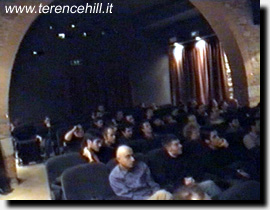 Tonino: The tricks are pretty basic, like each time Terence moves very fast, they were speeded up, otherwise it wouldn't have been possible. He actually moved slower than normal. He could have done them faster, but I had him do them slower so we could speed them up without making them look like a puppet (silly, editor). When he slaps poor Marc Mazza, this is a story to tell, the poor man, he was recently operated on his ear which had become completely deaf. It seems that they had to restore his inner ear so his balance was effected. For a while, until it was healed, he got very dizzy. Every time Terence slapped him, he would fall down. He had to struggle to do it right, and I'm grateful to him to this day, really. To make that bit of cinema, we had God's help. And Jean Martin (who played Sullivan, editor), the famous star of The Battle of Algiers, a big star, who was cast as the snob, when he walked onto the set, that was really a beautiful moment. He came to work, and when I met him I said, "I'm embarrassed to even tell you anything" He said, "No. No". He really put himself at the service of the whole project.
Tonino: The tricks are pretty basic, like each time Terence moves very fast, they were speeded up, otherwise it wouldn't have been possible. He actually moved slower than normal. He could have done them faster, but I had him do them slower so we could speed them up without making them look like a puppet (silly, editor). When he slaps poor Marc Mazza, this is a story to tell, the poor man, he was recently operated on his ear which had become completely deaf. It seems that they had to restore his inner ear so his balance was effected. For a while, until it was healed, he got very dizzy. Every time Terence slapped him, he would fall down. He had to struggle to do it right, and I'm grateful to him to this day, really. To make that bit of cinema, we had God's help. And Jean Martin (who played Sullivan, editor), the famous star of The Battle of Algiers, a big star, who was cast as the snob, when he walked onto the set, that was really a beautiful moment. He came to work, and when I met him I said, "I'm embarrassed to even tell you anything" He said, "No. No". He really put himself at the service of the whole project.
At the end of the memorable evening, Tonino Valerii said good-bye, and revealed a project he is currently working on.
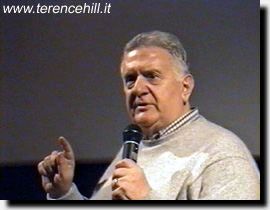 My relationship with cinema is a conflicted one, at times. With Sergio, there was and continues to be a brotherly friendship, but there was a small spat, which I believe was not his fault. I am currently writing a book that is called Dear Sergio where I relate everything that happened between Sergio Leone and me. I've already 64 draft pages and I'm at that point and it is very painful to write. But I have to write it because everyone has said to me, "No, you have to write it, not just for your relationship with Sergio Leone, but because you have to make things clear". It's a year that I've been trying to write it, but his arm of mine just doesn't want to obey me Now, after having spoken to a trusted friend, an elderly man who is 73 years old, a great screenwriter, who said to me, "Tonino, you have to write it", now I'm ready to write it. I hope to finish it before the end of the year. Greemese (the publisher, editor) is waiting for it, so I can promise you that the book will be published.
My relationship with cinema is a conflicted one, at times. With Sergio, there was and continues to be a brotherly friendship, but there was a small spat, which I believe was not his fault. I am currently writing a book that is called Dear Sergio where I relate everything that happened between Sergio Leone and me. I've already 64 draft pages and I'm at that point and it is very painful to write. But I have to write it because everyone has said to me, "No, you have to write it, not just for your relationship with Sergio Leone, but because you have to make things clear". It's a year that I've been trying to write it, but his arm of mine just doesn't want to obey me Now, after having spoken to a trusted friend, an elderly man who is 73 years old, a great screenwriter, who said to me, "Tonino, you have to write it", now I'm ready to write it. I hope to finish it before the end of the year. Greemese (the publisher, editor) is waiting for it, so I can promise you that the book will be published.
|